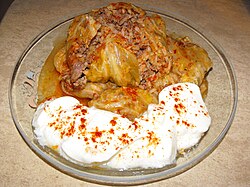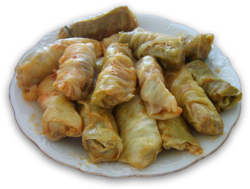Sarma (food): Difference between revisions
| Line 12: | Line 12: | ||
==Preparation== |
==Preparation== |
||
Minced [[meat]] (usually [[beef]], [[pork]], [[veal]], or a combination thereof, but also lamb, goat, sausage and various bird meat such as duck and goose), [[rice]], [[onions]], and various [[spices]], including [[edible salt|salt]], [[black pepper|pepper]] and various local [[herbs]] are mixed together and then rolled into large plant leaves, which may be [[cabbage]] (fresh or pickled), [[chard]], [[rumex|sorrel]], [[grapevine|vine leaf]] (fresh or pickled) or [[broadleaf plantain]] leaves. The combination is then boiled for several hours. While specific recipes vary across the region, it is uniformly recognized that the best cooking method is slow boiling in large clay pots. A special ingredient, [[flour]] browned in [[fat]] (called ''rântaş'' in Romania, where it may also contain finely chopped onion, or ''ajmpren'' in Slovenian), is often added at the end of the process. Other fine-tuned flavors include [[cherry tree]] leaves in some locations; other recipes require the use of pork fat—there are innumerable variations across the region. [[Vegetarian]] options as well as those made with [[fish]] exist. |
[[File:Sarmale with mamaligă.jpg|thumb|Sarmale with cream, [[mămăligă]], smoked mead and hot peppers]] Minced [[meat]] (usually [[beef]], [[pork]], [[veal]], or a combination thereof, but also lamb, goat, sausage and various bird meat such as duck and goose), [[rice]], [[onions]], and various [[spices]], including [[edible salt|salt]], [[black pepper|pepper]] and various local [[herbs]] are mixed together and then rolled into large plant leaves, which may be [[cabbage]] (fresh or pickled), [[chard]], [[rumex|sorrel]], [[grapevine|vine leaf]] (fresh or pickled) or [[broadleaf plantain]] leaves. The combination is then boiled for several hours. While specific recipes vary across the region, it is uniformly recognized that the best cooking method is slow boiling in large clay pots. A special ingredient, [[flour]] browned in [[fat]] (called ''rântaş'' in Romania, where it may also contain finely chopped onion, or ''ajmpren'' in Slovenian), is often added at the end of the process. Other fine-tuned flavors include [[cherry tree]] leaves in some locations; other recipes require the use of pork fat—there are innumerable variations across the region. [[Vegetarian]] options as well as those made with [[fish]] exist. |
||
[[File:Sarmalute mamaliguta.JPG|thumb|left|''Sarmale'', [[Romania|Romanian]] traditional food]] |
[[File:Sarmalute mamaliguta.JPG|thumb|left|''Sarmale'', [[Romania|Romanian]] traditional food]] |
||
In [[Turkey]], the word "sarma" is used interchangeably with [[dolma]] for stuffed vine leaves, [[cabbage]] or [[chard]]. Most of the time, the name of the vegetable used is added to describe the dish such as ''lahana sarma'' (cabbage) or ''yaprak sarma'' (grape leaves). As with dolma, sarma is combined with [[yoghurt]] when it contains minced meat (beef, meal, lamb) and is served hot. The filling of sarma in Turkey usually contains rice, herbs, onion, [[Zante currant|currant]]s and [[pine nut]]s, herbs such as [[parsley]] and [[dill]], and several spices including [[cinnamon]] and [[black pepper]]. |
In [[Turkey]], the word "sarma" is used interchangeably with [[dolma]] for stuffed vine leaves, [[cabbage]] or [[chard]]. Most of the time, the name of the vegetable used is added to describe the dish such as ''lahana sarma'' (cabbage) or ''yaprak sarma'' (grape leaves). As with dolma, sarma is combined with [[yoghurt]] when it contains minced meat (beef, meal, lamb) and is served hot. The filling of sarma in Turkey usually contains rice, herbs, onion, [[Zante currant|currant]]s and [[pine nut]]s, herbs such as [[parsley]] and [[dill]], and several spices including [[cinnamon]] and [[black pepper]]. |
||
Revision as of 10:07, 25 May 2011
This article possibly contains original research. (April 2011) |

Sarma is a dish of grape, cabbage or chard leaves rolled around a filling usually based on minced meat. It is found in the cuisines of the Balkans and Turkey as well as those of Central Europe, Central Asia and Middle East.
Etymology and names
Sarma means 'a wrapped thing' in Turkish, from the verb sarmak 'to wrap' or 'to roll'.[1] Sarma may also be called yaprak dolması 'filled leaf' or simply dolma 'stuffed thing'. Dolma, which properly refers to stuffed vegetables, is often conflated with sarma.
Besides the savory dish of leaf-wrapped filling, sarma in Greek can also refer to sweet pastries similar to baklava, saray sarma and fıstık sarma, which are prepared by wrapping phyllo dough around a mixture of crushed nuts and syrup.
The name sarma has been borrowed by many languages: South Slavic сармa/sarma, Romanian sarmale, Greek σαρμάδες; Arabic uses the Turkish word يبرق yabraq 'leaf' instead. Other names are descriptive: Azerbaijani: kələm dolması 'cabbage dolma, Hungarian: töltött káposzta 'stuffed cabbage', Greek λαχανοντολμάδες 'cabbage dolma, Arabic ملفوف [malfūf] 'cabbage'. Outside the Balkans, the Slavic and Moldovan name means 'little pigeon' (from the shape): Moldovan găluşti, Polish gołąbki, Russian: голубцы; cf. gołąbki.
Preparation

Minced meat (usually beef, pork, veal, or a combination thereof, but also lamb, goat, sausage and various bird meat such as duck and goose), rice, onions, and various spices, including salt, pepper and various local herbs are mixed together and then rolled into large plant leaves, which may be cabbage (fresh or pickled), chard, sorrel, vine leaf (fresh or pickled) or broadleaf plantain leaves. The combination is then boiled for several hours. While specific recipes vary across the region, it is uniformly recognized that the best cooking method is slow boiling in large clay pots. A special ingredient, flour browned in fat (called rântaş in Romania, where it may also contain finely chopped onion, or ajmpren in Slovenian), is often added at the end of the process. Other fine-tuned flavors include cherry tree leaves in some locations; other recipes require the use of pork fat—there are innumerable variations across the region. Vegetarian options as well as those made with fish exist.

In Turkey, the word "sarma" is used interchangeably with dolma for stuffed vine leaves, cabbage or chard. Most of the time, the name of the vegetable used is added to describe the dish such as lahana sarma (cabbage) or yaprak sarma (grape leaves). As with dolma, sarma is combined with yoghurt when it contains minced meat (beef, meal, lamb) and is served hot. The filling of sarma in Turkey usually contains rice, herbs, onion, currants and pine nuts, herbs such as parsley and dill, and several spices including cinnamon and black pepper.
In continental parts of Croatia, sarma is identical to the Bosnian type, and includes rice and minced meat, as well as dried smoked beef. However, in Dalmatia, there is a special subtype known as arambašići (named after Turkish soldiers — harambaše) typical of the Dalmatian hinterland. The stuffing of arambašići does not include rice, the meat is diced (rather than minced), and spices include lemon, cinnamon, cloves and muscat nuts. Unlike that of predominantly Muslim regions, sarma in Croatia is cooked in a pot with dry pork, prosciutto bone or sausages. It is traditionally served on New Year's Eve and weddings. In Serbia sarma is cooked the same way as in Croatia, by using sauerkraut leaves, ground meat, rice and seasonings. Sarma rolls are slowly simmered for a long time in large pots with lard and layers of smoked pork, seasoned with Vegeta (vegetable seasoning), bay leaves and paprika. Some family recipes include finishing sarma by baking it in oven which gives it distinctive flavor. Sarma is one of the staple meals for festive occasions like Christmas, New Year, Easter, birthdays, family saint patron's day (slava) etc. Also, there are various Serbian recipes of sarma prepared in accordance to Orthodox Christian religious restrictions on using meat and animal fat during period of Lent. Lenten sarma is usually stuffed with rice, shredded carrots, onions, seasonings, occasionally walnuts or even chunks of smoked fish, and cooked in water and vegetable oil.
It is also cooked by Italians who were exiled from Dalmatia after World War II, especially those who now live in northwestern Italy. Italian writer Enzo Bettiza included arambašići (sarma) as one of the five central meals of Dalmatian cuisine in his autobiographical book Esilio (Exile).


Unlike other Eastern European cultures, the people of Southeastern Europe overwhelmingly use sour cabbage as opposed to fresh cabbage. At the end of the autumn, families traditionally prepare the sour cabbage (as whole cabbage, or as individual leaves, but not shredded) for sarma-making.
Another kind of sarma are those rolled in (grape) vine leaves— smaller and with slightly different taste (see dolma).
Sarma is normally a heavy dish (though families are increasingly substituting the traditional pork fat with olive oil or other oils. Thus, it is usually eaten during winter. Traditionally, they are served along with polenta or potatoes, which are sometimes mashed. Other optional add-ons include sour cream, yogurt and horseradish.
Cabbage rolls served in tomato sauce, though common in North America, are much less common in Southeastern Europe. Unlike its Polish (Gołąbki) or Ukrainian equivalents, the filling is predominantly meat, as opposed to rice—in fact, it is only in recent times that rice has been added to sarma. Originally sarma was made with barley or, in dire times of low barley crops, with buckwheat.
Serving
In Turkey, sarma is eaten as an everyday, ordinary dish. There are also restaurants specializing in sarma.
In Slovenia, Bosnia and Herzegovina, Croatia, Serbia, Romania, Armenia, Bulgaria and the Republic of Macedonia sarmale (сарма) is a traditional meal for Christmas (in Serbia also for slava and Easter, and in Slovenia and Croatia for New Year's Day).
Traditionally, a pot filled with sarme/sarmale is usually prepared for an entire family. Sarma is often served as one of the main dishes during wedding ceremonies. In diasporic communities, it is often cherished as a reminder of their former homelands.[citation needed]
The popular Russian version is called "голубцы" (golubtsy), and is usually made of cabbage leaves.
In German cuisine a similar dish is known as Kohlrollen, Kohlrouladen or Krautwickel.
See also
References
- ^ A.D. Alderson and Fahir İz, The Concise Oxford Turkish Dictionary, Oxford, 1959
